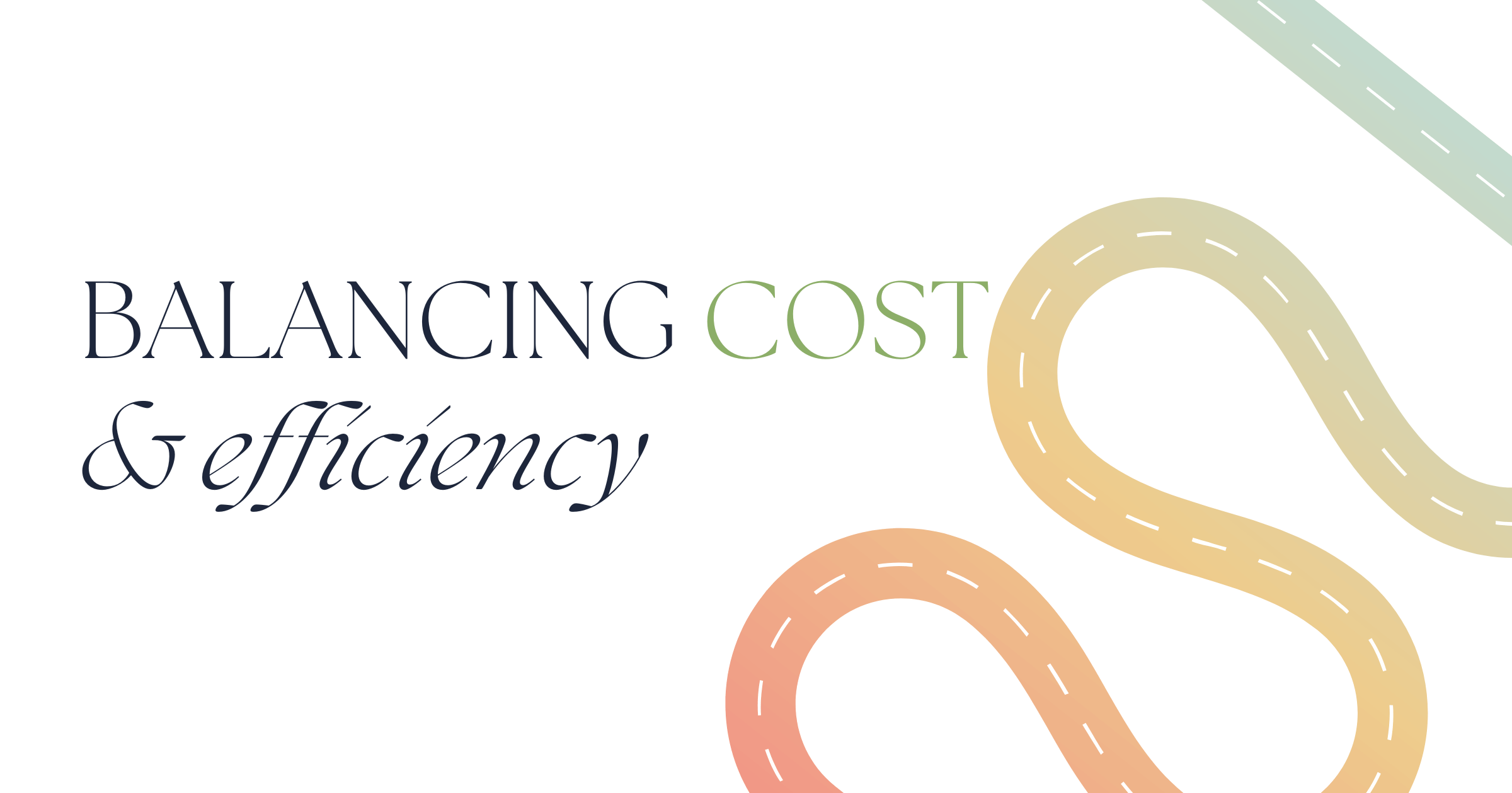
In construction, balancing cost and efficiency is a critical yet challenging task. Building projects, whether residential or commercial, must meet budget constraints while ensuring high performance, sustainability, and quality. This delicate equilibrium between cost and efficiency involves strategic planning, innovative solutions, and a comprehensive understanding of the project's lifecycle. Here are some notes on how to achieve this balance in building projects.
Understanding Cost and Efficiency
Cost Considerations
Initial Costs:
- Materials: The choice of materials significantly impacts the initial cost. While high-performance materials may have higher upfront costs, they can offer long-term savings. For instance, using high-efficiency insulation materials may increase initial expenses but significantly reduce heating and cooling costs over time.
- Labor: Skilled labor can be expensive, but it often results in higher quality and faster completion times. Investing in experienced professionals can lead to fewer mistakes and rework, ultimately saving money.
- Equipment: Investment in modern, efficient equipment can reduce labor costs and improve project timelines. For example, using advanced machinery for excavation or prefabrication can speed up the construction process and lower labor costs.
Lifecycle Costs:
- Maintenance: Efficient designs and durable materials reduce long-term maintenance costs. For example, using weather-resistant materials for exterior finishes can minimize the need for frequent repairs and repainting.
- Operational Costs: Energy-efficient systems can lower utility bills over the building's lifespan. Implementing high-efficiency HVAC systems, LED lighting, and smart home technologies can significantly reduce energy consumption.
- End-of-Life Costs: Sustainable deconstruction practices and recyclable materials can reduce disposal costs and environmental impact. Planning for the end of a building's life by choosing materials that can be easily recycled or repurposed can lower demolition and waste management costs.
Efficiency Considerations
Energy Efficiency:
- Insulation: Proper insulation reduces heating and cooling costs, enhancing overall energy efficiency. Using high-quality insulation materials in walls, roofs, and floors can significantly improve a building's thermal performance.
- HVAC Systems: High-efficiency HVAC systems, though more expensive initially, can offer significant savings over time. Implementing programmable thermostats and energy-efficient heating and cooling equipment can optimize energy use.
- Lighting: LED and other energy-efficient lighting options reduce energy consumption and maintenance needs. Utilizing natural lighting through strategically placed windows and skylights can also decrease the need for artificial lighting.
Resource Efficiency:
- Water Management: Efficient plumbing fixtures and rainwater harvesting systems lower water usage and costs. Installing low-flow faucets, toilets, and showerheads can reduce water consumption without sacrificing performance.
- Material Use: Prefabrication and modular construction minimize material waste and reduce costs. These construction methods allow for more precise material usage and can lead to faster build times and lower labor costs.
Time Efficiency:
- Project Management: Effective project management practices ensure timely completion, reducing labor and overhead costs. Using project management software and techniques like Gantt charts and the Critical Path Method can keep projects on schedule.
- Construction Techniques: Advanced construction techniques, such as prefabrication, can speed up the building process and reduce costs. Modular construction allows for simultaneous on-site preparation and off-site building assembly, leading to faster completion times.
Strategies for Balancing Cost and Efficiency
1. Integrated Design Process
An integrated design process involves all stakeholders, including architects, engineers, builders, and owners, from the project's inception. This collaborative approach ensures that cost and efficiency considerations are addressed at every stage, leading to more informed decisions and optimized outcomes. By incorporating input from all parties early on, potential issues can be identified and resolved before they become costly problems.
2. Value Engineering
Value engineering is a systematic method to improve the value of a project by examining functions and seeking cost-effective alternatives. This process involves:
- Function Analysis: Understanding the essential functions of building components. For instance, identifying the primary purpose of a wall (structural support, insulation, aesthetics) can help determine the most cost-effective materials to use.
- Cost-Benefit Analysis: Comparing the costs and benefits of different options to find the most cost-effective solutions without compromising performance. For example, choosing between different types of insulation based on their cost, thermal performance, and durability.
3. Sustainable Design and Construction
Incorporating sustainable practices can balance cost and efficiency by reducing long-term operational costs and enhancing building performance. Key sustainable strategies include:
- Energy Modeling: Using energy modeling software during the design phase to predict and optimize energy performance. This allows designers to make informed decisions about insulation, windows, and HVAC systems to maximize energy savings.
- Green Building Certifications: Pursuing certifications like LEED or BREEAM, which can guide the integration of cost-efficient, sustainable practices. These certifications provide a framework for achieving high performance in energy efficiency, water conservation, and indoor air quality.
4. Lifecycle Cost Analysis (LCCA)
LCCA is a method to assess the total cost of ownership, considering initial costs, operation, maintenance, and end-of-life costs. By evaluating the entire lifecycle, LCCA helps identify cost-saving opportunities and ensures that decisions made today will result in future savings. For example, investing in a more expensive roofing material with a longer lifespan can save money on replacements and repairs over time.
5. Investing in Technology
Modern technologies can enhance efficiency and reduce costs:
- Building Information Modeling (BIM): BIM allows for detailed planning, reducing errors and rework. By creating a digital representation of the building, all stakeholders can visualize and coordinate their work more effectively.
- Smart Systems: Incorporating smart building systems can optimize energy use and reduce operational costs. Smart thermostats, lighting controls, and energy management systems can adjust settings based on occupancy and usage patterns, leading to significant energy savings.
6. Choosing the Right Materials
Selecting materials that offer a balance of cost and performance is crucial. For example:
- High-Performance Insulation: While more expensive initially, it can significantly reduce heating and cooling costs. Materials like spray foam or rigid foam insulation provide better thermal resistance compared to traditional fiberglass.
- Recycled Materials: Often cheaper and more sustainable, recycled materials can reduce initial costs and environmental impact. Using reclaimed wood, recycled metal, or composite materials made from recycled plastics can contribute to sustainability goals while keeping costs down.
7. Efficient Project Management
Effective project management ensures that projects stay on schedule and within budget. Techniques include:
- Critical Path Method (CPM): Identifying the most critical tasks that could delay the project if not completed on time. CPM helps project managers prioritize activities and allocate resources efficiently.
- Lean Construction: Minimizing waste and maximizing value through efficient resource management. Lean construction principles focus on reducing inefficiencies, improving workflow, and enhancing collaboration among project team members.
Case Study: A Balanced Approach in Practice
Consider a mid-sized residential development aiming to balance cost and efficiency. The project team employs an integrated design process, involving all stakeholders from the beginning. Through value engineering, they identify cost-effective alternatives for high-performance windows and insulation. They use BIM to plan and simulate construction, reducing errors and delays.
The design incorporates sustainable features like solar panels and rainwater harvesting systems, which have higher upfront costs but significantly lower operational costs. An LCCA confirms that these investments will pay off in reduced energy bills over the building’s lifespan. Finally, effective project management ensures timely completion, keeping labor costs under control.
Final Thoughts
Balancing cost and efficiency in building projects requires a strategic and comprehensive approach. By integrating design processes, employing value engineering, adopting sustainable practices, and utilizing modern technologies, project teams can achieve this balance. The result is high-performing, cost-effective buildings that stand the test of time, offering both economic and environmental benefits.
Whether you’re embarking on a new construction project or renovating an existing structure, focusing on the balance between cost and efficiency will lead to more sustainable and successful outcomes. By understanding the full lifecycle costs, investing in energy-efficient technologies, and implementing effective project management practices, you can create buildings that are not only cost-effective but also environmentally friendly and efficient.











0 Comments